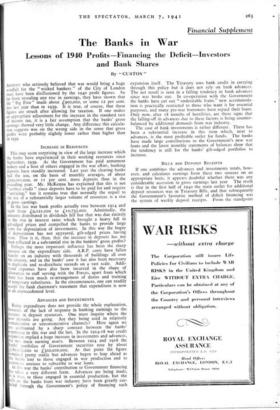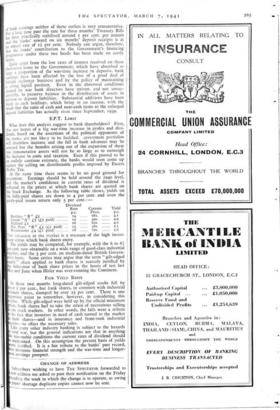Financial Supplement
The Banks in War
Lessons of 1940 Profits—Financing the Deficit—Investors and Bank Shares
By ‘‘ CUSTOS " ANYBODY who seriously believed that war would bring a huge windfall for the "wicked bankers" of the City of London must have been disillusioned by the 1940 profit figures. So far from revealing any rise in earnings, they have shown that the "Big Five" made about £900,000, or some 12 per cent. less last year than in 1939. It is true, of course, that these figures are struck after allowing for taxation. If one makes an appropriate adjustment for the increase in the standard rate of income tax, it is a fair assumption that the banks' gross earnings showed very little change. Any difference this calcula- tion suggests was on the wrong side in the sense that gross profits were probably slightly lower rather than higher than in 1939.
INCREASE IN RESOURCES
This may seem surprising in view of the large increase which the banks have experienced in their working resources since September, 1939. As the Government has paid armament makers and a host of others engaged in the war effort, banking deposits have steadily increased. Last year the clearing banks had the use, on the basis of monthly averages, of about £250,000,000, or ii per cent. more deposits than in the preceding year. Mr. McKenna has explained that this is not " costless credit" since deposits have to be paid for and require "servicing," but it remains true that normally the sequel to the use of a substantially larger volume of resources is a rise in gross earnings. In the last war bank profits actually rose between 1914 and 1916 from £9,121,000 to £10,735,000. Admittedly, the amounts distributed in dividends fell but that was due entirely to the rise in interest rates which brought a heavy fall in gilt-edged prices and compelled the banks to provide large sums for depreciation of investments. In this war the bogey of depreciation has not appeared, gilt-edged prices having risen. How is it, then, that the increase in deposits has not been reflected in a substantial rise in the bankers' gross profits? Perhaps the most important influence has been the sharp increase on the expenditure side. A.R.P. costs have fallen heavily on an industry with thousands of buildings all over the country, and in the banks' case it has also been necessary to duplicate and re-distribute records on a vast scale. Addi- tional expenses have also been incurred in the shape of allowances to staff serving with the Forces, apart from which there has been much re-arrangement of duties and training of temporary substitutes. In the circumstances, one can readily accept the bank chairmen's statement that expenditure is now at an unprecedented level.
ADVANCES AND INVESTMENTS
Rising expenditure does not provide the whole explanation, however. of the lack of response in banking earnings to the Increase in deposit resources. One must inquire where the ew deposits are going. Are they being used in relatively remunerative or unremunerative channels? Here again we are confronted by a sharp contrast between the banks' experience in this war and the last. In the 1914-18 war credit xpansion implied a huge increase in investments and advances. the two main earning assets. Between 1914 and 1916 the anks' portfolios of Government securities rose by about 180.oco,000 to i300,000,000. At that point the figure emainel pretty stable but advances began to leap ahead as he banks lent to those engaged in war production and to stoms:rs anxious to subscribe to war loans. In this war the banks' contribution to Government financing as taken a very different form. Advances are being made, t is true, to those engaged in essential production, but the ils On the banks from war industry have been greatly cur- tied through the Government's policy of financing such
•
expansion itself. The Treasury uses bank credit in carrying through this policy but it does not rely on bank advances. The net result is seen in a falling tendency in bank advances since war broke out. In co-operation with the Government the banks have cut out "undesirable loans," new accommoda- tion is practically restricted to those who want it for essential purposes, and many pre-war borrowers have repaid their loans. Only now, after 18 months of hostilities, are there signs that the falling-off in advances due to these factors is being counter- balanced by additional demands from war industry.
The case of bank investments is rather different. There has been a substantial increase in this item which, next to advances, is the most profitable outlet for funds. The banks have made large contributions to the Government's new war loans and the latest monthly statements of balances show that the tendency is still for the banks' gilt-edged portfolios to increase.
BILLS AND DEPOSIT RECEIPTS If one combines the advances and investments totals, how- ever, and calculates earnings from these two sources on an appropriate basis, it appears doubtful whether there was any considerable accession to gross earnings last year The truth is that in the first half of 1940 the main outlet for additional deposit resources was in Treasury Bills, and that subsequently the Government's favourite method of deficit financing was the system of weekly deposit receipts. From the standpoint of bank earnings neither of these outlets is very remunerative. For a long time past the rate for three months' Treasury Bills has been practically stabilised around i per cent, per annum and the banks' reward on six months' deposit receipts is at an annual rate of xi per cent. Nobody can argue, therefore, that the banks' contribution to the Government's financing programme under these two heads has been made on costly
terms.
Quire apart from the low rates of interest received on these short-term loans to the Government, which have absorbed so large a proportion of the war-time increase in deposits, bank earnings have been affected by the loss of a good deal of foreign exchange business and by the policy of maintaining a strong liquid position. Even in the abnormal conditions created by war bank directors have striven, and not unsuc- cessfully, to preserve balance in the distribution of assets in relation to deposit liabilities. Substantial additions have been nude to cash holdings, which bring in no income, with the result that the ratio of cash and near-cash items to the enlarged deposit liabilities has actually risen since September, 1939.
E.P.T. LIMIT What does this analysis suggest to bank shareholders? First, that any hopes of a big war-time increase in profits and divi- dends, based on the assertions of the political opponents of the banks, are not likely to be fulfilled. investment portfolios will doubtless increase and the fall in bank advances may be arrested but the benefits arising out of the expansion of these two remunerative assets will not be so large as to outweigh the increase in costs and taxation. Even if this proved to be an unduly cautious estimate, the banks would soon come up against the ceiling on distributable profits imposed by Excess Profits Tax.
At the same time there seems to be no good ground for pessimism. Earnings should be held around the 1940 level, and the market's confidence in current rates of dividend is reflected in the prices at which bank shares are quoted on the Stock Exchange. As the following table shows, yields on the fully-paid shares are down to 4 per cent. and even the partly-paid issues return only 5 per cent.: —
Barclays " B " Li Lloyds " A " £5 (kr paid)
Midland £r Nat. Prov. " B " £5 (£r paid)
Westminster £4 (Lx paid) Dividend Rate p.c.
14 12
i6
...55 18 Current Price.
68s.
49s.
8os.
58s.
72s.
Yield P.C. 4.1 4.9 4.0 5.1 5.0 his valuation in the market is a measure of the high invest- ent status which bank shares enjoy.
guides, and the 3 per cent. on medium-dated British Govern- quity " often applied to bank shares is scarcely justified by ay and June when Hitler was over-running the Continent. FAIR YIELD BASIS In those two months long-dated gilt-edged stocks fell by Mary shares, slumped by over 25 per cent. There is one ecline While gilt-edged were held up by the official minimum Like every other industry banking is subject to the hazards total but the general indications are that in anything war, immense financial strength and the war-time and longer- in earnings prospect. The yields may be compared, for example with the 6 to 61- r cent, now obtainable on a wide range of good-class industrial ent loans. Some critics may argue that the term "gilt-edged behaviour of bank share prices in the hours of test last bout 5 per cent., but bank shares, in common with industrial port ant point to remember, however, in considering this ees, bank shares had to take the strain of necessitous selling the stock markets. In other words, the falls were a tribute the fact that investors in need of cash turned to the market bank shares—and in insurance and front-rank industrial aities—to effect the necessary sales.
reasonable conditions the current rates of dividend should maintained. On this assumption the present basis of yields Justified. It is a fair tribute to the banks' past record,































 Previous page
Previous page